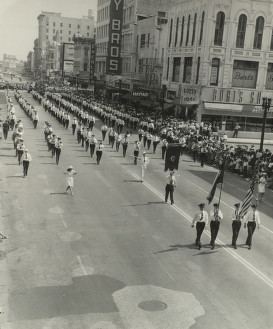 | ||
Synchronization is the coordination of events to operate a system in unison. The familiar conductor of an orchestra serves to keep the orchestra in time. Systems operating with all their parts in synchrony are said to be synchronous or in sync; those which are not are asynchronous.
Contents
Today, synchronization can occur on a global basis through the GPS-enabled timekeeping systems (and similar independent systems operated by the EU and Russia).
Transport
Time-keeping and synchronization of clocks was a critical problem in long-distance ocean navigation; accurate time is required in conjunction with astronomical observations to determine how far East or West a vessel has traveled. The invention of an accurate marine chronometer revolutionized marine navigation. By the end of the 19th century, time signals in the form of a signal gun, flag, or dropping time ball, were provided at important ports so that mariners could check their chronometers for error.
Synchronization was important in the operation of 19th century railways, these being the first major means of transport fast enough for the differences in local time between adjacent towns to be noticeable. Each line handled the problem by synchronizing all its stations to headquarters as a standard railroad time. In some territories, sharing of single railroad tracks was controlled by the timetable. The need for strict timekeeping led the companies to settle on one standard, and civil authorities eventually abandoned local mean solar time in favor of that standard.
Communication
In electrical engineering terms, for digital logic and data transfer, a synchronous circuit requires a clock signal. However, the use of the word "clock" in this sense is different from the typical sense of a clock as a device that keeps track of time-of-day; the clock signal simply signals the start and/or end of some time period, often very minute (measured in microseconds or nanoseconds), that has an arbitrary relationship to sidereal, solar, or lunar time, or to any other system of measurement of the passage of minutes, hours, and days.
In a different sense, electronic systems are sometimes synchronized to make events at points far apart appear simultaneous or near-simultaneous from a certain perspective. (Albert Einstein proved in 1905 in his first relativity paper that there actually are no such things as absolutely simultaneous events.) Timekeeping technologies such as the GPS satellites and Network Time Protocol (NTP) provide real-time access to a close approximation to the UTC timescale and are used for many terrestrial synchronization applications of this kind.
Synchronization is an important concept in the following fields:
Dynamical systems
Synchronization of multiple interacting dynamical systems can occur when the systems are autonomous oscillators. For instance, integrate-and-fire oscillators with either two-way (symmetric) or one-way coupling can synchronize when the strength of the coupling (in frequency units) is greater than the differences among the free-running natural oscillator frequencies. Poincare phase oscillators are model systems that can interact and partially synchronize within random or regular networks. In the case of global synchronization of phase oscillators, an abrupt transition from unsynchronized to full synchronization takes place when the coupling strength exceeds a critical threshold. This is known as the Kuramoto model phase transition. Synchronization is an emergent property that occurs in a broad range of dynamical systems, including neural signaling, the beating of the heart and the synchronization of fire-fly light waves.
Human movement
Synchronization of movement is defined as similar movements between two or more people which are temporally aligned. This is different to mimicry, as these movements occur after a short delay. Muscular bonding is the idea that moving in time evokes particular emotions. This sparked some of the first research into movement synchronization and its effects on human emotion.
In groups, synchronization of movement has been shown to increase conformity, cooperation and trust however more research on group synchronization is needed to determine its effects on the group as a whole and on individuals within a group. In dyads, groups of two people, synchronization has been demonstrated to increase affiliation, self-esteem, compassion and altruistic behaviour and increase rapport. During arguments, synchrony between the arguing pair has been noted to decrease, however it is not clear whether this is due to the change in emotion or other factors. There is evidence to show that movement synchronization requires other people to cause its beneficial effects, as the effect on affiliation does not occur when one of the dyad is synchronizing their movements to something outside of the dyad. This is known as interpersonal synchrony.
There has been dispute regarding the true effect of synchrony in these studies. Research in this area detailing the positive effects of synchrony, have attributed this to synchrony alone; however, many of the experiments incorporate a shared intention to achieve synchrony. Indeed, the Reinforcement of Cooperation Model suggests that perception of synchrony leads to reinforcement that cooperation is occurring, which leads to the pro-social effects of synchrony. More research is required to separate the effect of intentionality from the beneficial effect of synchrony.
Uses
Some systems may be only approximately synchronized, or plesiochronous. Some applications require that relative offsets between events be determined. For others, only the order of the event is important.
